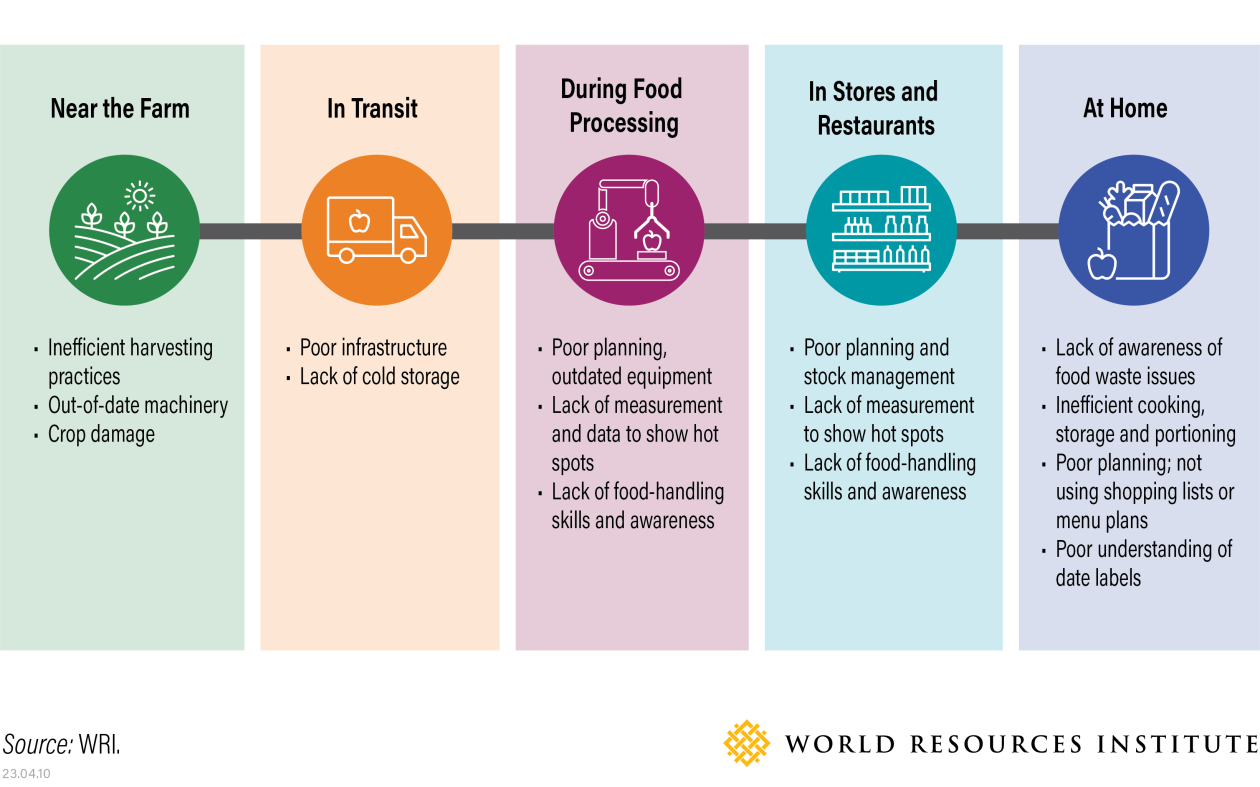This article is part of the Sustainability Letter. Subscribe to receive more content on sustainability at the University of Luxembourg.
Globally, it’s estimated that about one-third of all food produced for human consumption is wasted. This food, if consumed, would be enough to feed two billion people—more than twice the number of undernourished individuals globally. The scale of global food waste and hunger, not only reveals the inefficiencies in our global food system but also illuminates the paradox of plenty, where excess and shortage exist in stark contrast. Addressing food waste could contribute to achieving several Sustainable Development Goals (SDGs), such as zero hunger (Goal 2), sustainable cities and communities (Goal 11), responsible consumption and production (Goal 12), and climate action (Goal 13). However, SDG 12.3 specifically targets food waste, aiming to ‘By 2030, halve per capita global food waste at the retail and consumer levels and reduce food losses along production and supply chains, including post-harvest losses’.
What is food waste?
Food waste occurs along the entire spectrum of production, from the farm to distribution to retailers to the consumer. Reasons include losses from mold, pests, inadequate climate control, or intentional food waste. This waste is categorized differently based on where it occurs: Food “loss” occurs before the food reaches the consumer as a result of issues in the production, storage, processing, and distribution phases while food “waste” refers to food that is fit for consumption but consciously discarded at the retail or consumption phases.
The true cost of food waste
The environmental impact of food waste is substantial. However, its true cost extends beyond ecological damage; it also includes social and economic dimensions that are deeply interconnected and influence one another. From a financial perspective, food waste accounts for about 1.3 billion tons annually, with an estimated value of US $1 trillion. Socially, the issue is complex; our global food system is leading to hunger and malnutrition in some areas while simultaneously contributing to waste in other places. The environmental impacts of food waste are primarily in two sectors: resource consumption and greenhouse gas emissions.
Food waste implies that 28% of the world’s arable land is cultivated in vain, amounting to 13.44 million square kilometres. To put this in perspective, this area exceeds the size of Canada, which covers 9.98 million square kilometres. The water wasted in this process is equally staggering, totalling 250 cubic kilometers per year, which is equivalent to almost seven years of water consumption in Canada.
In a study conducted by Poore & Nemecek (2018), it was found that 6% of all global greenhouse gas (GHG) emissions come from food losses and waste. Their study did not consider the initial phase that occurs on the farm, but they calculated that 3.75% of GHG emissions come from losses in the supply chain, and 2.25% come from consumer waste. Regarding CO2 emissions, 3.3 gigatons of greenhouse gases are released annually from food waste decomposing in landfills. If wasted food were a country, it would rank as one of the top emitters of carbon dioxide globally, following China, the USA, and India, which emit 13.9, 6, and 4 gigatons respectively.
What can be done?
To understand how we can mitigate food waste, we first need to identify the stages at which food loss and waste occur (Figure N 1).
Food wastage can be observed in five distinct phases: harvesting, storage and transportation, processing (supply), and at the retail and consumer levels (demand). In addressing the supply phase, stricter rules, regulations, and adequate monitoring might be the solution while the demand phase relates to the individual’s behaviour. The EU platform has provided some recommendations for action in food waste prevention in all stages, as illustrated in Table N1.

Table N1: Recommendations for action in food waste prevention developed by the EU platform
| Level | Recommendations |
| Primary production | – Strengthen financial support to farms to drive modernisation with a focus on tackling food losses and food waste – Include farmers and their cooperatives and farming service providers in research and innovation activities from the beginning of the process |
| Manufacturing stage | – Better planning/forecasting for raw material buying – Take full account of the critical role of packaging in ensuring food quality, safety and preventing food waste – Offer consumers the right portion size |
| Retail stage | – Make food waste prevention/reduction a company priority – Greater use of food repurposing in store (e.g. processing unsold fruit/vegetables) |
| Food services | – Help to influence consumer expectations/behaviour to reduce and prevent plate waste |
| Consumer level | – Individual and community behaviour change |
Transitioning to the legislative aspect, different governments have passed various laws and legislation, implementing action plans to achieve the goal. Specifically in Luxembourg, the National Waste and Resource Management Plan aims to halve food waste by 2030. Statistically speaking, on average, each Luxembourger generates a total of 119 kg of food waste annually during the demand stage. Breaking this down, the average waste per person amounts to 9 kg at the retail level, 21 kg within food services, and 89 kg at the household level. By contrast, the global average for household food waste stands at 74 kg per person. Reflecting on the national efforts, the progress made so far in Luxembourg is remarkable, with initiatives such as ‘Antigaspi’ Awareness Campaign, Food Sharing, and the ‘Null Offall Lëtzebuerg’ Strategy, to name but a few.
A need for a systemic reform
The global challenge of food waste is not only an environmental and socio-economic concern but is also a moral imperative in a world where so many go without it. Tackling this issue necessitates a multifaceted approach that engages stakeholders at every level, from production to consumption. Although the volume of greenhouse gas emitted from food loss exceeds that of food waste, the focus of laws, regulations, and even studies predominantly target the demand phase. This margin may stem from Sustainable Development Goal 12.3, which specifies a reduction of waste at the consumer level by half and a more ambiguous directive to decrease losses in the supply chain. The term ‘half’ conveys a clear target and quantifiable objective, whereas ‘reduce’ remains indeterminate, allowing for any degree of change. While it is understandable that combating food waste at the individual level may seem more manageable, one must question whether it is just more convenient for authorities to shift the responsibility onto consumers rather than undertaking systemic reform. Ultimately, the fight against food waste is a shared responsibility that demands collaborative efforts. Taking simple steps, such as making routine changes or increasing awareness among family and friends about this matter, can help significantly.
